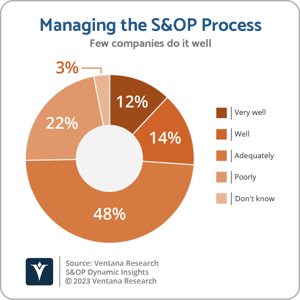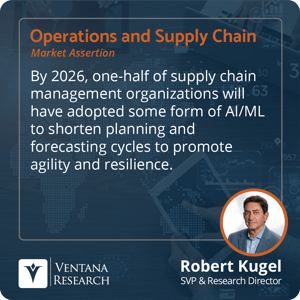We’ve experienced an unusual, decades-long monetary policy in the developed world that emphasized interest rate repression as well as supply chain practices designed for lowest cost. This has produced a generation of chief financial officers likely unprepared to address the impact of fundamental changes now shaping a new, technology-driven approach to working capital optimization. Today’s CFOs must assess their working capital management processes and the systems that support them to balance the need to minimize the cost of working capital against customer requirements such as delivery times and order fulfillment. Technology can minimize frictions – and therefore costs – associated with managing inventories, receivables and payables balanced against customer satisfaction requirements and legal and regulatory considerations.
It’s important to acknowledge that an organization’s optimal working capital practices, standards and constraints vary considerably depending on its industry, business customs and strategies. There is a fundamental division between product-type organizations that need to plan and manage supply and demand chains and maintain inventories, verses service businesses that typically hold relatively smaller amounts of inventory. Nonetheless, all organizations can benefit from using technology to:
- Minimize the costs of holding inventories while respecting customer satisfaction objectives.
- Achieve the right balance of receivables and payables.
- Reduce the costs of managing the transactions themselves.
In 2019, I first pointed out a fundamental shift in the forces that shape world trade. This shift was having, and would continue to have, a profound impact on how organizations design and manage supply chains – specifically the shift from lowest cost to a balance between cost and resiliency. The impact of the pandemic and continued geopolitical shifts accelerated that trend. It has resulted in broader adoption of sales and operations planning systems and adapted practices that strengthen resiliency and the agility to adapt to surprise events affecting supply and demand.
Still, as with most business software there is a lag between software implementation and transforming business practices to make best use of the software. This is reflected in our Sales and Operations Dynamic  Insights research, finding that only 26% of organizations manage sales and operations planning processes well or very well. Typically, there are multiple underlying factors, but, in our experience, inadequate technology, data adequacy and quality issues are common.
Insights research, finding that only 26% of organizations manage sales and operations planning processes well or very well. Typically, there are multiple underlying factors, but, in our experience, inadequate technology, data adequacy and quality issues are common.
Of course, the importance of deft planning and management is a function of the length of an organization’s supply chain. Businesses that are reliably able to replenish necessary inventories within a month or two face a far less rigorous task than those that rely on sourced parts and materials or contract manufacturing that have months-long lead times, travel long distances or are vulnerable to disruption caused by political, operational, legal or regulatory events.
Computer-supported inventory optimization is a decades-old, well-established discipline. Technology continues to provide more comprehensive support, enabling organizations to better manage the trade-offs in making inventory decisions. For example, the accessibility of real-time inventory tracking continues to expand, allowing more organizations to have deeper and more complete understanding of the logistical disposition of inventory in real time, enabling better-informed decisions on when and how much inventory to order as well as from which supplier or location.
Easier application of predictive analytics and artificial intelligence to inventory management is just beginning to enable more informed decisions. Plus, those involved in the process will benefit from increased productivity, as  more of the routine work that requires little or no judgment is handled by systems, freeing up individuals to take on tasks that require experience and judgment. Ventana Research asserts that by 2026, one-half of supply chain management organizations will adopt some form of artificial intelligence with machine learning to shorten planning and forecasting cycles, promoting agility and resilience. Reducing latency and frictions in inventory management processes increases the ability for demand-driven inventory management.
more of the routine work that requires little or no judgment is handled by systems, freeing up individuals to take on tasks that require experience and judgment. Ventana Research asserts that by 2026, one-half of supply chain management organizations will adopt some form of artificial intelligence with machine learning to shorten planning and forecasting cycles, promoting agility and resilience. Reducing latency and frictions in inventory management processes increases the ability for demand-driven inventory management.
At the same time, managing inventories has become more complex as buyers in both business and consumer commerce increasingly demand multichannel options, including e-commerce, online marketplaces and brick-and-mortar stores. More recently, the focus on environmental impact has increased attention on decisions such as distribution center locations, shipment scheduling and transportation routes.
Achieving the optimal balance between accounts receivable and accounts payable is a longstanding concern of finance department executives. The quick ratio is calculated by dividing the sum of cash, marketable securities and accounts receivable by short-term liabilities, notably accounts payable. It is a conservative financial metric that indicates an organization’s ability to quickly convert liquid assets into cash to pay for its short-term financial obligations and thus weather events that create temporary cash flow problems. The really old-school view held that quick assets should be twice current liabilities, but as access to liquidity expanded and financial practices evolved, the ideal number has come down. In the 1980s, when real interest rates were high, more than a few well-capitalized CFOs with easy access to credit strove to keep payables well above receivables to earn incremental interest on the cash float. The optimal balance between A/R and A/P depends on an organization’s circumstances, but can be better managed by having greater end-to-end visibility and control of the order-to-cash and procure-to-pay processes. Using software to manage both of these makes it possible to achieve greater precision and control. And because software or services designed for end-to-end management can reduce frictions in executing tasks, it can reduce the costs associated with A/R and A/P management. For this reason the Office of Finance practice added Purchasing, Sourcing and Payments as one of our six areas of focus.
I believe a significant challenge in managing finance and accounting departments today is that those CFOs old enough to recall a time when there were real and rising interest rates, and the difficulty of paper- and fax-based supply chain management systems have either retired or are not attuned to the advantages that technology confers on working capital optimization. Those that are younger likely haven’t experienced conditions that would enable them to appreciate the impact of changes that have transformed working capital management over the past five years. I recommend all CFOs undertake a thorough working capital management review to identify a comprehensive approach to planning and executing strategies that address the demands of the business while reducing costs associated with consistently achieving agility, resiliency and customer service objectives.
Regards,
Robert Kugel

 Insights research, finding that only 26% of organizations manage sales and operations planning processes well or very well. Typically, there are multiple underlying factors, but, in our experience, inadequate technology, data adequacy and quality issues are common.
Insights research, finding that only 26% of organizations manage sales and operations planning processes well or very well. Typically, there are multiple underlying factors, but, in our experience, inadequate technology, data adequacy and quality issues are common. more of the routine work that requires little or no judgment is handled by systems, freeing up individuals to take on tasks that require experience and judgment. Ventana Research asserts that by 2026, one-half of supply chain management organizations will adopt some form of artificial intelligence with machine learning to shorten planning and forecasting cycles, promoting agility and resilience. Reducing latency and frictions in inventory management processes increases the ability for demand-driven inventory management.
more of the routine work that requires little or no judgment is handled by systems, freeing up individuals to take on tasks that require experience and judgment. Ventana Research asserts that by 2026, one-half of supply chain management organizations will adopt some form of artificial intelligence with machine learning to shorten planning and forecasting cycles, promoting agility and resilience. Reducing latency and frictions in inventory management processes increases the ability for demand-driven inventory management.








